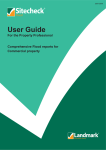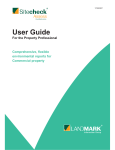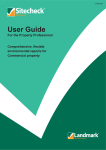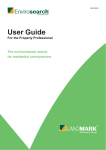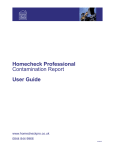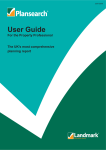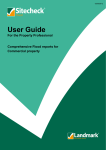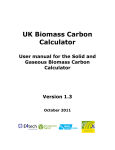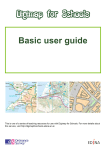Download User Guide - Envirocheck
Transcript
26/10/2012 User Guide For the Environmental Professional Comprehensive environmental information for site assessments Envirocheck Export User Guide Envirocheck Export User Guide Table of Contents Introduction to Envirocheck Export 3 Ordering Envirocheck Export 3 Envirocheck Export Output 4 Data Licensing 5 Appendix Appendix Appendix 1: Data Sets Currently Available in Envirocheck Export 6 2 Envirocheck Export User Guide 1. Introduction 1.1 Envirocheck Export is an innovative online service from Landmark Information Group, designed to provide fast and flexible access to GIS and CAD-ready digital mapping and data. Landmark understands that sometimes, especially on large or complex projects, there is a requirement for flexibility and functionality that only digital formats can offer. We recognise that requirement and this is why we have developed a way to access and download digital data for GIS and CAD systems, providing flexible data delivery for flexible data requirements. Envirocheck Export provides a fast and flexible approach to digital data: Digital mapping and data held in one convenient location, reducing the need to spend time searching and collating data from several disparate sources Digital mapping and data fully licensed for commercial use under a single, managed license Polygon upload functionality of .shp or .dxf files allowing quick and easy specification of the area for which mapping or data is required Orders for digital mapping and data can be placed through the familiar and easy to use envirocheck.co.uk website Saves time by removing the need to digitise features of interest by hand Choose from a variety of digital formats to suit your needs, including Geotiff, Shape, DXF, TAB, and other common formats Fast data delivery via email download Envirocheck Export is the fast, flexible and efficient service for all your digital mapping and data needs. 2. Ordering Envirocheck Export 2.1 You are able to order an Envirocheck Export through www.envirocheck.co.uk using your existing user name and password. If you do not already have an account you can register on-line or contact our Customer Services as detailed below: Landmark Information Group Limited The Smith Centre Fairmile Henley-on-Thames Oxon RG9 6AB Telephone: 0844 844 9952 Fax: 0844 844 9951 E-mail: [email protected] 3 Envirocheck Export User Guide 2.2 You can locate the area for which you require data using the normal address or grid reference search functions or by uploading a shape or DXF file. Please note that the area you digitise or upload in your shape or DXF file needs to cover the entire area for which you require data. There is no facility for manual buffer selection as with other Envirocheck reports. 2.3 There are restrictions imposed by the data supplier on the maximum area for which data may be exported. For the datasets currently included in Envirocheck Export the maximum area is 200 square kilometres, with the exception of the RMS Flood Hazard data which is limited to 100 square kilometres. 2.4 For questions about any aspect of our Envirocheck services please contact Customer Services using the details above. 3. Envirocheck Export Output 3.1 The datasets currently available in Envirocheck Export are detailed in appendix 1. 3.2 Output formats can be selected for different data groups as follows: Mapping GeoTIFF (Default) ESRI World MapInfoTab OS Mastermap AutoCAD DXF AutoCAD DWG GML Data Mapinfo Tab (Default) AutoCAD DXF Autodesk SDF AutoCAD DWG ESRI Shape GML Digitised Site MapInfo Tab (Default) AutoCad DXF ESRI Shape 3.3 With the exception of EA Lidar the data can be delivered via an e-mail link or on CD. The e-mail link will remain operative for a period of 45 days, after which time it will not work. You should ensure that any data you have ordered is downloaded within that period. Data will normally be available for download within 24 hours. Provided the data files are generated in time, orders placed on a normal working day before 12 noon for delivery on CD will normally be dispatched on the same day. 4 Envirocheck Export User Guide Orders placed after 12 noon for delivery on CD, those where the data files did not completely generate during the previous day, or those placed at weekends and bank holidays, will be dispatched on the next working day. CD's will be despatched by courier using a pre 10 am delivery service. 3.4 EA Lidar data is obtained in real time from the Environment Agency and is not produced from Landmark's database. Whilst every effort will be made to obtain this data within 24 hours this cannot be guaranteed. EA Lidar data will be delivered separately to any other data ordered as an e-mail attachment or on CD, depending on the file size. CD's will be despatched by courier using a pre 10 am delivery service. 4. Data Licensing 4.1 The data supplied in your Order is supplied for a 12 month licence period unless terminated by either party in accordance with our Terms and Conditions. The Terms and Conditions also set out the rights and restrictions with regard to your use of the data. Please note the licence will take effect on the date that you indicated acceptance of the Terms and Conditions by placing your order. Following expiry of this period the licence shall automatically terminate and you are obliged to destroy or permanently delete all copies of the relevant Report and Content subject to a limited right to retain archive copies as detailed in the Terms and Conditions. 4.2 Landmark will send a licence expiry reminder email to clients two weeks before their licence expires advising that the mapping/data should be deleted or purchased again if the project is ongoing. 5 Envirocheck Export User Guide Appendix 1 : Data Sets Currently Available in Envirocheck Export Title Remarks Source Data Type Data Range Update Cycle Section 1:10,000 Colour Raster Mapping 1:10 000 Scale Raster map data is the most detailed product in the Ordnance Survey raster portfolio. It provides large-scale background mapping upon which information can be added or overlaid. 1:10 000 Scale Raster can be combined with other data in a geographical information system (GIS), enabling visualisation of a wide range of information within a geographical context. The level of feature detail makes 1:10 000 Scale Raster particularly useful for analysing data within urban and rural areas. It provides a comprehensive map base ideal for detailed work, such as site management or environmental analysis. Ordnance Survey Mapping Not Applicable Quarterly Current Mapping 1:25,000 Colour Raster Mapping The 1:25 000 Scale Colour Raster data product mirrors the popular OS Explorer Map series, showing a detailed overview of environmental and leisure features. It can provide the ideal mapping backdrop upon which to overlay business information. 1:25 000 Scale Colour Raster’s backdrop can then be overlaid with other Ordnance Survey vector products or a customer’s own geographical/business data, besides being a useful background map in its own right. Access areas as defined by the Countryside Agency under the Countryside Rights of Way Act 2000 have been depicted on 1:25 000 Scale Colour Raster since 2004. Ordnance Survey Mapping Not Applicable Bi-annually Current Mapping 1:50,000 Colour Raster Mapping 1:50 000 Scale Colour Raster is the definitive Ordnance Survey raster map providing a complete digital view of the popular Landranger paper map series. 1:50 000 Scale Raster comprises 815 tiles, each 20 km by 20 km, and offers clear detail on roads, footpaths, woods, water features, important buildings and height contours. All topographic features are joined across sheet edges, providing seamless coverage of the entire country. 1:50 000 Scale Raster provides a comprehensive map base ideal for detailed work where street names are not required. Ordnance Survey Mapping Not Applicable Annually Current Mapping Ancient Woodland This dataset defines areas of Ancient Woodland in Natural England England, Scotland and Wales and is sourced from Natural England, Scottish Natural Heritage and the Countryside Countryside Council for Wales. Ancient Woodland is Council for Wales a term used in the United Kingdom to refer specifically Scottish Natural to woodland dating back to 1600 or before in England Heritage and Wales, or 1750 in Scotland. The inventories were started by the UK government’s Nature Conservancy Council in the 1980s, and have been maintained by its successor organisations. Ancient Woodland has been identified by determining their presence or absence from contemporary and historical maps, ground survey, and aerial photography. The inventories are under a constant system of review and are updated as new information is received, or as older data is matched to the Forestry Commission’s more recent National Inventory of Woodland and Trees. Within the English and Welsh inventories, only ancient woodland sites that were over 2 hectares on the 1920’s base maps were initially included, although in a small number of cases e.g. the Weald and Mid-Sussex Woodland Surveys, areas have been remapped to include woodland areas under 2 hectares. In addition, some woodland areas on the inventory may now be smaller than 2 hectares due to subsequent clearing since 1920. The English and Welsh inventories define ancient woodland as land that has had continuous woodland cover since at least 1600AD and may be Ancient Semi-Natural Woodland or Plantation on Ancient Woodland Sites. Point & Polygon Not Applicable Bi-annually Constraints Polygon & Text Not Applicable Bi-annually Polygon & Text Not Applicable Bi-annually 6 Envirocheck Export User Guide Appendix 1 : Data Sets Currently Available in Envirocheck Export Title Remarks Source Data Type Data Range Update Cycle Section Environment Agency Polygon & Text From 2005 Quarterly EA Flood Data Ancient Woodland Ancient Semi-Natural Woodland are sites that have (Continued) retained the native tree and shrub cover that has not been planted, although it may have been managed by coppicing or felling and allowed to regenerate naturally. This woodland may well be more than 400 years old making it our only link to how British woodland would have been 1000 years ago. Plantation on Ancient Woodland are sites where the original native tree cover has been felled and replaced by planting, usually with conifers and usually within the last century. During the 1950s many broadleaves were felled and conifers planted to meet the expected demand for fencing and the construction industry. There have been some very recent schemes to cut down these conifers and replace them with native species of tree and shrub in order to return the woodland to how it would have been 400 years ago. The English and Welsh ancient woodland boundaries are digitised to OS MasterMap, however, the maps that they are based upon include the OS 1” First Edition maps, the OS 1:25 000 and the OS 1:50 000 maps. The boundaries cannot be taken as precise, especially where they are surrounded by woodland, and are only precisely comparable with other boundaries at the 1” map scale (1:63,360). Like England and Wales the Scottish Inventory was begun by the Nature Conservancy Council in the 1980s, first published in 1987 and has been widely used for woodland management, local planning and strategic policy development. The decision to capture the boundaries digitally in Scotland was taken in 1994. Continuity of woodland cover (of at least 2 hectares on 1970 mapping) was determined by evidence from contemporary (OS 1970’s 1:25,000 series) and historical maps (OS First Edition c.1850 and The Military Survey of Scotland - ‘Roy maps’ c.1750). A more sophisticated classification was developed for woodlands in Scotland due to the nature of the available historical sources. Five categories were identified, and these determine whether the woodland is of semi-natural or plantation origin, and the longevity and continuity of this woodland. Due to the age and scale of some of the historical Scottish maps, there are limitations to the quality of some of the boundaries, and some may appear shifted. There is also some uncertainty over the extent of woodland shown on the original Roy maps, which means the number and area of Scottish Ancient Woodlands is likely to have been underestimated. Areas Benefiting from Flood Defences Areas of Outstanding Natural Beauty This data set shows those areas benefiting from demarcated flood defences whereby in a 1% fluvial or 0.5% tidal flood event, areas that would otherwise flood are protected, provided that the defences do not breach. Polygon & Not Applicable Not Applicable Department for The National Parks and Access to the Countryside Text Environment, Act 1949 as amended by the Countryside Act 1968, Food and Rural Wildlife and Countryside Act 1981 and Environment Act 1995, allowed for the designation of Areas Affairs (DEFRA) of Outstanding Natural Beauty (AONB). (The Countryside Polygon & Not Applicable Bi-Annually equivalent designations for Scotland are National Council for Wales Text Scenic Areas). Natural England Polygon & Text Not Applicable Annually AONBs are landscapes of national conservation importance for their distinctive character and natural beauty. They are generally smaller than National Parks, and are owned by individuals e.g. farmers. Some are adjacent to National Parks and many include areas of Heritage Coast. The aims of AONBs are to enhance and conserve the natural beauty of the landscape; meeting the need for quiet enjoyment and having regard for the interests of those who live and work there. Planning law protects development within them. Constraints 7 Envirocheck Export User Guide Appendix 1 : Data Sets Currently Available in Envirocheck Export Title Remarks Source Data Type Data Range Update Cycle Section British Geological Survey (BGS) Polygon & Text Not Applicable Annual Additional Flood Data This data set identifies areas prone to the two main British Geological types of flooding - inland (fluvial floodplains) and Survey (BGS) coastal/estuarine, based upon the observation of the types of geological deposit present. The data set is a digital map based on the BGS Digital Geological Map of Great Britain at the 1:50,000 scale. It was produced by characterising Superficial (Drift) Deposits on this map in terms of their likely vulnerability to flooding, either from coastal or inland water flow. These Superficial Deposits are considered ‘recent’ in geological terms, most having been formed in the later parts of the Quaternary geological period (i.e. within the last few tens of thousands of years). Observations made during recent major inland and coastal flooding events have demonstrated that the erosion and deposition of these recent geological sediments have produced subtle topographical variations, resulting in landforms such as fluvial and coastal floodplains. The mapping of these landforms, in conjunction with the fluvial and/or coastal deposits that underlie them, has in turn determined the extent of previous coastal and inland flooding. The data set does not take into account any manmade influences such as flood protection schemes, nor does it take into account the possibility of flooding onto low-lying ground that is not occupied by the ‘indicator’ deposits described above. Polygon & Text Not Applicable Annually Additional Flood Data Ordnance Survey Polygon Not Applicable Bi-Annually Administrative BGS Groundwater This data set is the first national hazard or Flooding susceptibility data set of groundwater flooding. Susceptibility Groundwater flooding is increasingly recognised as a hazard and can be defined as the emergence of groundwater at the ground surface, or the rising of groundwater into man-made ground under conditions where the normal range of groundwater levels is exceeded. Based on geological and hydrogeological information, digital data has been used to identify areas where geological conditions could enable groundwater flooding to occur and where groundwater may come close to the ground surface. The data set defines areas with one of five levels of groundwater susceptibility, ranging from high susceptibility to negligible or no susceptibility. Areas with no data represent areas with no susceptibility to groundwater flooding. The resolution of the modelled output is 50m by 50m cells. The data set is a hazard data set, not a risk data set, meaning that it does not provide any information about the likelihood of a groundwater flooding event occurring. BGS Geological Indicators of Flooding Boundaries Local Authorities This is a boundary data set containing polygon features which define local authority areas. Local authorities are classified as District councils, London Borough councils, Metropolitan District councils and Unitary authorities. These boundaries were sourced from the OS Boundary Line district borough unitary data set. In order to give this data set full GB coverage, the Isle of Scilly boundary has been added from the OS Boundary Line county data set. Although the Isles of Scilly has been classified as a county council by OS Boundary Line, it is in reality a Unitary authority. The source mapping scale for all features within this data set is 1:10,000. 8 Envirocheck Export User Guide Appendix 1 : Data Sets Currently Available in Envirocheck Export Title Remarks Source Data Type Data Range Update Cycle Section Boundaries - County Councils and Greater London Authority This is a boundary data set containing polygon features which define England’s County Council areas and the Greater London Authority boundary. The boundaries have been sourced from the OS Boundary Line county data set, although Landmark have removed the Isles of Scilly boundary and added this to the Boundaries - Local Authorities data set, as it is better classified as a Unitary local authority, rather than a county council. A county council is the elected administrative body governing an area known as a county, and exists in a two-tier system where local government functions are divided between county councils and district councils, county councils being responsible for more strategic services in a region. However, the data set does not have full coverage in England, because in some areas of England a one-tier governmental system of unitary authorities or metropolitan districts exists. Typically unitary authorities cover large towns or cities, which are large enough to be independent of county or regional administration. Metropolitan districts are to a large extent the same as unitary authorities after the abolition of metropolitan county councils, although some functions were taken over by joint bodies such as Passenger Transport Authorities, and joint fire, police and waste disposal authorities. The absence of county level administration within Unitary authority and Metropolitan district areas mean that these areas are not represented in this data set. The Greater London Authority (GLA) administers the 1579 km² of Greater London, covering the 32 London boroughs and the City of London, which are also administered at the local authority level. The GLA was created to improve the coordination between the London borough authorities, and has responsibility for areas such as transport, policing, fire and rescue, development and strategic planning. There is a one-to-one relationship between feature key and boundary (e.g. Devon County Council). There is a one-to-many relationship between feature key and feature geometry key as individual boundaries have been chopped to increase the efficiency of spatial queries. The source mapping scale for all features within this data set is 1:10,000. Ordnance Survey Polygon Not Applicable Bi-Annually Administrative Boundaries - Parishes and Communities This is a boundary data set containing polygon features which define Civil Parishes (England) and Communities (Wales). These are divisions of Districts (themselves divisions of Counties), or divisions of Unitary Authorities or Metropolitan Districts where appropriate. OS has made this dataset full GB coverage, by infilling areas not defined as a Civil Parish or Community (including the whole of Scotland) with polygons which define then as Non-Civil Parish or Community areas. These infill polygons have not been loaded by Landmark. These boundaries were sourced from the OS Boundary Line Parish data set. The source mapping scale for all features within this data set is 1:10,000. Ordnance Survey Polygon Not Applicable Bi-Annually Administrative 9 Envirocheck Export User Guide Appendix 1 : Data Sets Currently Available in Envirocheck Export Title Country Parks Detailed River Network Lines Remarks Source This dataset is sourced from the Natural England, Natural England Scottish Natural Heritage (SNH) and the Countryside Council for Wales (CCW) and represents a full set Countryside of Country Parks in England, Scotland and Wales. Council for Wales Country Parks are public green spaces often at the Scottish Natural edge of urban areas which provide open-air places Heritage to enjoy the outdoors and experience nature in an informal semi-rural park setting. The Natural England data contains boundaries of English Country Parks, digitised against Ordnance Survey MasterMap (1:1250 scale) using source maps supplied by Local Authorities. There are over 400 Country Parks in England, although as at February 2009 the English dataset is only 75% complete. There are 36 Scottish Country Parks and 33 Welsh Country Parks, these being digitised to a scale of approximately 1:10,000. Country Parks are normally actively managed and have facilities such as car parks, toilets, paths, trails, visitor information and perhaps cafes or kiosks . Parks may also be supported by a Ranger Service to promote visitor enjoyment, organised events and understanding of their natural qualities. There is not necessarily public right of access, although most are publicly accessible; some charge entry others don’t. Most are owned and managed by Local Authorities with support from the relevant Country’s Natural Environment government body i.e. Natural England, SNH, or CCW. Many Country Parks were designated during the 1970s. In England and Wales they were designated by the Countryside Commission, under the Countryside Act 1968. More recently Country Parks have been created under a less formal arrangement and with little or no specific financial support. Natural England and CCW are working with partners to encourage a renaissance and accreditation of parks which meet certain criteria. In Scotland, Country Parks have been established by Local Authorities under Section 48 of the Countryside (Scotland) Act 1967. This Act gives local authorities power to assess and review the need for Country Parks in consultation with SNH. This data describes the rivers, drains and streams which can be found in England and Wales. The Detailed River Network (DRN) Lines dataset is a drainage centreline dataset captured primarily from the water features theme of Ordnance Survey’s (OS) MasterMap Topography Layer, at three separate scales: 1:1,250, 1:2,500 and 1:10,000. DRN geometry is linked back to the contributing OS MasterMap topographic water features following the principles of the Digital National Framework (DNF) and is designed to represent a continuous, detailed network of water flows. The DRN Lines dataset is the primary feature class of the DRN dataset - line features that represent the river network. The data contains some features located in Scotland where water features either flow into or originate in Scotland. Environment Agency Data Type Data Range Update Cycle Section Point & Polygon Not Applicable Bi-annually Constraints Point & Polygon Not Applicable Bi-annually Point & Polygon Not Applicable Bi-annually Line & Text Current As notified EA Detailed River Network Data 10 Envirocheck Export User Guide Appendix 1 : Data Sets Currently Available in Envirocheck Export Title Remarks Source Data Type Data Range Update Cycle Section Detailed River Network Nodes This data describes the river, drain and stream node intersections which divide the detailed river network data. The Detailed River Network (DRN) Nodes dataset is captured primarily from the water features theme of Ordnance Survey’s (OS) MasterMap Topography Layer, at three separate scales: 1:1,250, 1:2,500 and 1:10,000. DRN geometry is linked back to the contributing OS MasterMap topographic water features following the principles of the Digital National Framework (DNF) and includes node features which appear when there is a physical change in the network. Nodes are defined as being one of the following: A source, sink junction, or pseudo node, interactions or not assigned. The DRN Nodes dataset is a point feature dataset that represents the nodes of the DRN features. The data contains some features located in Scotland where water features either flow into or originate in Scotland. Environment Agency Point & Text Current As notified EA Detailed River Network Data Detailed River Network Offline Drainage This data describes water features that do not connect into the detailed river network. The Detailed River Network (DRN) Offline Drainage dataset is a drainage centreline dataset captured primarily from the water features theme of Ordnance Survey’s (OS) MasterMap Topography Layer, at three separate scales: 1:1,250, 1:2,500 and 1:10,000. DRN geometry is linked back to the contributing OS MasterMap topographic water features following the principles of the Digital National Framework (DNF) and includes water features from OS MasterMap that do not connect into the river network and are generally limited in length. The data contains some features located in Scotland where water features either flow into or originate in Scotland. Environment Agency Line & Text Current As notified EA Detailed River Network Data Development Plans This data set is a listing of all the development plans published by Local Authorities and County Councils in England, Scotland and Wales. It includes not just Local Plans, Unitary Plans and National Park Plans, but also details of Structure Plans, Mineral Plans, Waste Plans, Mineral & Waste Plans and Regional Park Plans. Various Polygon & Text Current As notified Local Development Plans Extreme Flooding from Rivers or Sea without Defences (Zone 2) Flood Zones are defined by the Government’s Planning Policy Statement 25 on ‘Development and Flood Risk’ for England (PPS25) dated December 2006, which replaces Planning Policy Guidance 25: Development and Flood Risk (PPG25), published in July 2001. The Flood Zones are defined in table D.1 of PPS25 and illustrate the probability of flooding across England for planning consultation and have been identified using the best available data held by the Environment Agency ignoring the presence of flood defences. This data set is Flood Zone 2 (Medium Probability), which comprises areas of land assessed as having between a 1 in 100 and 1 in 1000 annual probability of river flooding (1% – 0.1%) or between a 1 in 200 and 1 in 1000 annual probability of sea flooding (0.5% – 0.1%) in any year. This definition of Flood Zone 2 applies only in England. Equivalent data is also provided for Wales, although in Wales the data does not have the same relationship to Planning Policy and is not referred to as Flood Zones. Environment Agency Polygon & Text From 2005 Quarterly EA Flood Data Flood Defences This is the Environment Agency’s holding of Linear Flood Defences. This data set contains all flood defences constructed during the last five years with a standard of protection equal to or better than 1% for rivers and 0.5% from the sea. Some additional defences, which may be older or may have been designed to provide a lower standard of protection, are also shown where the information is currently available. This layer comprises linear flood defences, for example flood embankments and walls. Environment Agency Polygon & Text From 2005 Quarterly EA Flood Data 11 Envirocheck Export User Guide Appendix 1 : Data Sets Currently Available in Envirocheck Export Title Remarks Source Data Type Data Range Update Cycle Section Flooding from Rivers or Sea without Defences (Zone 3) Flood Zones are defined by the Government’s Planning Policy Statement 25 on ‘Development and Flood Risk’ for England (PPS25) dated December 2006, which replaces Planning Policy Guidance 25: Development and Flood Risk (PPG25), published in July 2001. The Flood Zones are defined in table D.1 of PPS25 and illustrate the probability of flooding across England for planning consultation and have been identified using the best available data held by the Environment Agency ignoring the presence of flood defences. This data set combines Flood Zone 3a (High Probability) and Flood Zone 3b (The Functional Floodplain). Flood Zone 3a comprises land assessed as having a 1 in 100 or greater annual probability of river flooding (>1%) or a 1 in 200 or greater annual probability of flooding from the sea (>0.5%) in any year. Flood Zone 3b comprises land where water has to flow or be stored in times of flood. Strategic Flood Risk Assessments (SFRAs) should identify this Flood Zone (land which would flood with an annual probability of 1 in 20 (5%) or greater in any year or is designed to flood in an extreme (0.1%) flood, or at another probability to be agreed between the LPA and the Environment Agency, including water conveyance routes). These definitions of Flood Zone 3a and 3b apply only in England. Equivalent data is also provided for Wales, although in Wales the data does not have the same relationship to Planning Policy and is not referred to as Flood Zones. Environment Agency Polygon & Text From 2005 Quarterly EA Flood Data Flood Hazard 75,100 and 1,000 Year Return This dataset describes the surface water and major Risk Management river flood hazard for 75,100 and 1,000 year return Solutions Inc. periods for England, Scotland & Wales. A return period is the statistical probability of the flood happening in any given year. i.e. a 75 year return period is a 1 in 75 chance. The Risk Management Solutions (RMS) data model does not take into account Coastal/Storm Surge Flooding, Dam Failure Flooding, Sewer Overflow Flooding or risk of flooding from the sea. The source data is created using 0.0005 decimal degree grid cells projected using WGS84 (Lat/Long). Landmark has translated the data into British National Grid - as a result of the translation, the data does not appear as a regular grid. Due to this re-projection cell sizes will vary across the country. Two types of major river flood hazard classification are used: defended and undefended. The “defended” data assumes any flood defences present withstand the flood heights for which they were designed. The “undefended” data assumes that no flood defences are present, representing the possible outcome if any defences which are present are breached entirely. The defended dataset makes certain assumptions about flood defences around Great Britain. RMS state these assumptions take into account EA defences, the government defence assumptions from DEFRA, other literature, and discussions with the EA especially around river flood defences in London and the impact of tidal defences along the river including the Thames barrier. This data has flood depth information, grouped into four bands: 0-200mm, 201-500mm; 501-2,000mm; 2,000mm and over. Surface water flood hazard is defined in this context as flooding from minor rivers, water flowing across the ground or raised groundwater levels. The surface water hazard does not make any account for any flood defences which may be present. Polygon & Text Not Applicable As Notified RMS Flood Data 12 Envirocheck Export User Guide Appendix 1 : Data Sets Currently Available in Envirocheck Export Title Remarks Source Data Type Data Range Update Cycle Section Flood Water Storage Areas The Environment Agency’s holding of ‘Flood Storage Areas’. A flood storage area may be referred to as a balancing reservoir, storage basin or balancing pond. Its purpose is to attenuate an incoming flood peak to a flow level that can be accepted by the downstream channel. It may also delay the timing of a flood peak so that its volume is discharged over a longer time interval. Environment Agency Polygon & Text From 2005 Quarterly EA Flood Data Green Belt This data is supplied to the Office of the Deputy Prime Minister by Landmark. The data is produced in a digital format and is then verified against the local plan of the area. In England, the Town and Country Planning Act 1990 as amended by the Planning and Compensation Act 1991 defines the scope of and framework for preparation of Structure and Local Plans, and the administration of development control. The Town and Country Planning (Scotland) Act 1972 as amended by the Planning and Compensation Act 1991 and Country Planning (Scotland) Act 1997 is the equivalent legislation for Scotland. Green belt is an area of principally open countryside surrounding existing built-up areas, the purpose of which is to check the unrestricted sprawl of the builtup area and to safeguard the surrounding countryside against further encroachment. The general principle of green belt is a provision against further development. Local Authorities Polygon & Text From last Local Plan As published Sensitive Land Uses Historic Battlefields The English Heritage Register of Historic Battlefields identifies 43 important English Battlefields, from 69 sites currently researched for selection. The purpose of the register is to offer them protection and to promote a better understanding of their significance. To satisfy selection onto the register three criteria have been used: Political significance of the engagement, Military historical significance, and Biographical significance. This data has been captured and validated against the current OS digital products and at 1:10,000 scale base and source mapping English Heritage Polygon & Text Not Applicable Bi-annually Constraints Historic Parks, Gardens and Designed Landscapes This dataset represents the captured boundaries of Historic Parks, Gardens and Designed Landscapes. The Natural England dataset of Historic Parks and Gardens (including other designed landscapes such as town squares), and the Historic Scotland dataset of Historic Gardens and Designed Landscapes (including parks) provide coverage for England and Scotland. The English register currently contains approximately 1,600 sites, whilst the Scottish inventory has approximately 390 sites on the continually growing list. This data has been captured against the current OS digital mapping products, mostly at the 1:10,000 base and source mapping scale. Polygons represent the area extent of the parks, gardens or designed landscapes, albeit they are purely indicative and designed for information purposes only (the supplied boundaries hold no legal status themselves). In order to recognise the existence of those sites which are of particular historic importance, English Heritage is enabled by Section 8C of the Historic Buildings and Ancient Monuments Act 1953 to compile the Register of Parks and Gardens of special historic interest in England. To qualify for being registered as a historic park or garden, the site must be over 30 years old and will be deemed of to be of national recognition dependant upon its main layout and features, its rarity as an example of historic landscape design and the quality of the landscaping. Natural England Polygon & Text Not Applicable Bi-Annually Constraints Historic Scotland Polygon & Text Not Applicable Bi-Annually 13 Envirocheck Export User Guide Appendix 1 : Data Sets Currently Available in Envirocheck Export Title Remarks Historic Parks, Gardens and Designed Landscapes (continued) Likewise, significant historic gardens and designed landscapes in Scotland are identified by Scottish Natural Heritage and Historic Scotland and placed on an inventory for their natural heritage and cultural importance. Inclusion in the Inventory confers a measure of statutory planning control in relation to the sites concerned and their setting through the Town and Country Planning (General Development Procedure) (Scotland) Order 1992 (GDPO) and SDD Circular No 6/1992. Historic Scotland focuses on safeguarding this invaluable resource, from threats such as inappropriate development including road building, new industry or housing. Historic Scotland advise that inclusion of a site in the Inventory does not necessarily mean that there are established, formal, access arrangements. Members of the public are advised to seek permission from the owner and/ or occupier in the normal way. Source Data Type Data Range Update Cycle Section Historical 1:1250 Scale Mapping This dataset comprises Ordnance Survey 1:1250 Ordnance Survey/ scale post-war National Grid A, B, C and D edition Landmark mapping. A joint venture between Ordnance Survey and Landmark Information Group Ltd created this Historical Mapping data in digital form by scanning the original paper maps from the Ordnance Survey archive. Each paper map was scanned to produce raster images which have been de-skewed as much as possible to align the maps north and south. A number of factors affect the quality of the scanned image, for example ingrained dust on the maps. The paper of some maps has become slightly distorted, affecting the overall geometry of the map. As a result, these maps are not perfect rectangles and once de-skewed there may be some loss of data and a less than perfect join when the digital images are lined up. However this only occurs in a small number of the maps scanned. Historical Mapping data is available for different time periods and the exact published dates of the various map editions vary depending on the location. The 1:1250 scale mapping covers a time period dating from approximately 1945 to 1996. These maps were not produced for all areas of the country and cover mainly built-up areas. Mapping Various Not Applicable Historical Mapping Historical 1:2500 Scale Mapping This dataset comprises Ordnance Survey 1:2500 Ordnance Survey/ scale pre-war County Series mapping and 1:2500 Landmark scale post-war National Grid A, B, C and D edition mapping. A joint venture between Ordnance Survey and Landmark Information Group Ltd created this Historical Mapping data in digital form by scanning the original paper maps from the Ordnance Survey archive. Each paper map was scanned to produce raster images which have been de-skewed as much as possible to align the maps north and south. A number of factors affect the quality of the scanned image, for example ingrained dust on the maps. The paper of some maps has become slightly distorted, affecting the overall geometry of the map. As a result, these maps are not perfect rectangles and once de-skewed there may be some loss of data and a less than perfect join when the digital images are lined up. However this only occurs in a small number of the maps scanned. Historical Mapping data is available for different time periods and the exact published dates of the various map editions vary depending on the location. The 1:2500 scale mapping covers a time period dating from approximately 1850 to 1996. It should be noted that not all editions were produced for all areas of the county. Mapping Various Not Applicable Historical Mapping 14 Envirocheck Export User Guide Appendix 1 : Data Sets Currently Available in Envirocheck Export Title Data Type Data Range Update Cycle Section Historical 1:10,000 This dataset comprises Ordnance Survey 1:10,000 Ordnance Survey/ Landmark Scale Mapping scale post-war National Grid mapping. A joint venture between Ordnance Survey and Landmark Information Group Ltd created this Historical Mapping data in digital form by scanning the original paper maps from the Ordnance Survey archive. Each paper map was scanned to produce raster images which have been de-skewed as much as possible to align the maps north and south. A number of factors affect the quality of the scanned image, for example ingrained dust on the maps. The paper of some maps has become slightly distorted, affecting the overall geometry of the map. As a result, these maps are not perfect rectangles and once deskewed there may be some loss of data and a less than perfect join when the digital images are lined up. However this only occurs in a small number of the maps scanned. Historical Mapping data is available for different time periods and the exact published dates of the various map editions vary depending on the location. The 1:10,000 scale post-war National Grid mapping covers a time period dating from approximately 1970 to 1996. It should be noted that not all editions were produced for all areas of the county. Mapping Various Not Applicable Historical Mapping Historical 1:10,560 This dataset comprises Ordnance Survey 1:10,560 Ordnance Survey/ Scale Mapping scale pre-war County Series mapping and 1:10,560 Landmark scale post-war National Grid mapping. A joint venture between Ordnance Survey and Landmark Information Group Ltd created this Historical Mapping data in digital form by scanning the original paper maps from the Ordnance Survey archive. Each paper map was scanned to produce raster images which have been de-skewed as much as possible to align the maps north and south. A number of factors affect the quality of the scanned image, for example ingrained dust on the maps. The paper of some maps has become slightly distorted, affecting the overall geometry of the map. As a result, these maps are not perfect rectangles and once de-skewed there may be some loss of data and a less than perfect join when the digital images are lined up. However this only occurs in a small number of the maps scanned. Historical Mapping data is available for different time periods and the exact published dates of the various map editions vary depending on the location. The 1:10,560 scale mapping covers a time period dating from approximately 1850 to 1970. It should be noted that not all editions were produced for all areas of the county. Mapping Various Not Applicable Historical Mapping Mapping From 1944 to 1951 Not Applicable Historical Mapping Historical Aerial Photos Remarks The data set comprises Historical Aerial Photos which were produced by the Ordnance Survey at 1:1,250 and 1:10,560 scale from Royal Air Force photography. Produced between 1944 and 1951 they were an interim measure, pending preparation of conventional mapping, due to post war resource shortages. New security measures in the 1950’s meant that every photograph was re-checked for potentially unsafe information with security sites replaced by fake fields or clouds. The original editions were withdrawn and only later made available after a period of fifty years although, due to the accuracy of the editing, without viewing both revisions it is not easy to spot the edits. Where available both revisions are included. Source Ordnance Survey 15 Envirocheck Export User Guide Appendix 1 : Data Sets Currently Available in Envirocheck Export Title Remarks Source Data Type Data Range Update Cycle Section Historical Building Plans This data set comprises of Historical Building Plans that were produced by the London-based firm Charles E. Goad Ltd. as fire insurance plans, dating back to 1885. The firm ceased production of fire insurance plans in 1970. Most of the important towns and cities of the British Isles are covered. Historical Building Plans are usually at the scales of 1:480 (1 inch to 40 feet) for the British Isles. They were updated every 5-6 years by means of revision sheets designed to be pasted on to the original plans. Landmark Mapping From 1885 to 1970 Not Applicable Historical Mapping Historical Flood Events This Environment Agency dataset describes the outlines of Historic Flood Events. Environment Agency Polygon & Text Not Applicable Quarterly Flood Data The current supply contains recorded flood events from 1703 to October 2008. The data also contains information on the source and cause of the flood, and how the flood outline was established. Historical Flood Liabilities From historical mapping dating back to the middle Ordnance Survey/ Landmark of the 19th century, Landmark’s Systematic Analysis Department has identified where areas liable to flooding have been recognized. This is drawn from a series of up to six historic map editions - up to four Ordnance Survey 1:10,560 County Series Maps (usually pre-W.W.II), the first National Grid Black and White raster 1:10,560 map and the last National Grid edition Black and White raster map at 1:10,000 scale. Point & Text Various Not Applicable Additional Flood Data Historical Town Plans This data set comprises Historical Town Plans which Ordnance Survey/ Landmark are detailed pre World War II Ordnance Survey County Series maps produced from the survey of towns with a population of over 4,000. A joint venture between Ordnance Survey and Landmark Information Group Ltd created this Historical Mapping data in digital form by scanning the original paper maps from the Ordnance Survey archive. Each paper map was scanned to produce raster images which have been de-skewed as much as possible to align the maps north and south. A number of factors affect the quality of the scanned image, for example ingrained dust on the maps. The paper of some maps has become slightly distorted, affecting the overall geometry of the map. As a result, these maps are not perfect rectangles and once de-skewed there may be some loss of data and a less than perfect join when the digital images are lined up. However this only occurs in a small number of the maps scanned. Historical Mapping data is available for different time periods and the exact published dates of the various map editions vary depending on the location. These maps are at scales of 1:500, 1:528, 1:1,056, 1:2,640 and 1:5,280. The 1:5,280 scale mapping covers London only. Historical Town Plans cannot be ordered separately in Envirocheck Export, they can only be ordered as part of the “Historical Maps (1:2,500 scale)” product in Export. Mapping Various Not Applicable Historical Mapping 16 Envirocheck Export User Guide Appendix 1 : Data Sets Currently Available in Envirocheck Export Title Remarks Source Data Type Data Range Update Cycle Section LiDAR (Light Detection and Ranging) This dataset, produced by the Environment Agency (EA), provides a Digital Terrain Model produced from 25cm resolution LiDAR. LiDAR (Light Detection and Ranging) is an airborne laser mapping technique which produces accurate elevation data. It uses optical remote sensing technology that measures properties of scattered light to find range and/or other information of a distant target. LiDAR has revolutionised the acquisition of digital elevation data and has quickly become the primary method of collecting height and surface information for a large number of applications and analysis. It is the quickest, most accurate and cost effective method of obtaining ground and surface height information. LiDAR is a highly viable option for all applications that require height, volume or 3D visualisation information. The EA LIDAR data has a vertical accuracy typically in the range of +/-5cm to 15cm, with the spatial resolutions ranging from 25cm to 2 metres. The EA Geomatics Group owns two airborne LIDAR systems, including a state-of-the-art Optech ALTM Gemini, which allows very high resolution data to be collected at a range of flying heights. The Geomatics Group have developed processes that allow surface objects such as vehicles, buildings and vegetation to be identified and removed, producing a ‘bare earth’ Digital Terrain Model (DTM). The standard product delivery includes the DTM, as well as the Digital Surface Model (DSM) where all surface objects are included. Areas of the country have been flown from 1998 up to December 2008 and data updates maybe made at the discretion of the Environment Agency. Environment Agency Raster Various As Notified LiDAR Listed Buildings This data set includes point features for Listed Buildings within England, as supplied by English Heritage. The supplied data includes approximately 365,000 point features and 10,000 polygon features. The word ‘listing’ is a short-hand term used to describe one of a number of legal procedures which help English Heritage to protect the best of architectural heritage. When buildings are confirmed to be listed they are placed on statutory list of buildings of ‘special architectural or historic interest’ compiled by the Secretary of State for Culture, Media and Sport under the Planning (Listed Buildings and Conservation Areas) Act 1990, on advice from English Heritage. It is worth noting that structures that might not be first thought of as buildings, such as railings, gates, war memorials and post boxes can also appear on the system. English Heritage Point, Polygon & Text Not Applicable Bi-annually Constraints Historic Scotland Point, Polygon & Text Not Applicable Bi-annually 17 Envirocheck Export User Guide Appendix 1 : Data Sets Currently Available in Envirocheck Export Title Local Nature Reserves Local Development Plans Remarks Source Data Type Data Range Update Cycle Section Polygon & Text Not Applicable Bi-annually Constraints Polygon & Text Not Applicable Bi-annually Polygon & Text Not Applicable As notified Scottish Natural Heritage Polygon & Text Not Applicable Bi-annually Various Polygon & Text Current As Notified Local Development Plans Various Point & Polygon Current As Notified Local Development Plans Environment Agency Point & Polygon Not Applicable Quarterly Flood Data Point & Polygon Not Applicable Bi-annually Constraints Point & Polygon Not Applicable Bi-annually Point & Polygon Not Applicable Bi-annually These reserves are areas created by Local Authorities Natural England in conjunction with their appropriate national authority in the interest of conservation, amenity value and Countryside public enjoyment of the countryside. Some, but not all Council for Wales Local Nature Reserves (LNRs) are also designated Local Authorities SSSIs. They are controlled by bylaws. Local Development Plans consist of Local Plans and Local Development Framework documents and are collected from Local Authorities throughout Great Britain. Local planning authorities are required to prepare planning strategies for their area in accordance with Sections 36 and 54 of the Town and Country Planning Act 1990 (as amended) in England and Wales, and Section 2 of the Town and Country Planning (Scotland) Act 1997. Plans are produced by district councils, unitary councils and National Park authorities in which detailed policies are set out to guide development in the Local Authority area. The plans may include detailed proposals for individual sites as well as identifying areas suitable for housing, industry, retail, conservation or other land uses. The plan forms the statutory basis for planning decisions and provides a means of public consultation and control over development. Depending upon the stage of consultation with the public, Plans are unadopted (e.g., ‘deposit’ plans) or adopted. The Local Development Framework (LDF) is gradually replacing the previous system of development plans which comprise of Local Plans and Structure Plans. It is a non-statutory term used to describe a folder of documents, which includes all the local planning authority’s local development documents. An LDF is comprised of: ~ Development Plan Documents (which form part of the statutory development plan) ~ Supplementary Planning Documents Local This data set contains current Local Development Development Plan Plan documents held on the Landmark database. Tracker National Flood Risk Assessment National Nature Reserves The National Flood Risk Assessment (NaFRA) provides an indication of flood risk at a national level. The data has been created by calculating the actual likelihood of flooding to areas of land within the flood plain of an extreme flood (0.1% or 1 in 1000 chance in any year). The method considers the probability that the flood defences will overtop or breach, and the distance of the impact cell from the river or the sea. It enables a comparison of the relative risks and their distribution within each of these catchments, rather than a detailed, local assessment of the risk at a specific location. EA do not hold information on properties (including floor levels). NaFRA data can therefore only assess if there are properties within the impact cells where EA have assessed the flood risk. These reserves have been designated under the Natural England Wildlife and Countryside Act 1981 or the National Parks and Access to the Countryside Act 1949, Countryside Section 19, as areas of high national or international Council for Wales importance for nature conservation. They are Scottish Natural designated by Natural England, Scottish Natural Heritage Heritage and the Countryside Council for Wales. There are three main categories of tenure for National Nature Reserves. These areas are owned, leased or managed by their relevant authority. National Nature Reserves are Sites of Special Scientific Interest, and may have coastal frontage or be offshore islands. 18 Envirocheck Export User Guide Appendix 1 : Data Sets Currently Available in Envirocheck Export Title Remarks National Nature Reserves (continued) These are digitised from base mapping at a scale 1:10,000. The boundaries are not the definitive version of the designated area: the legally definitive boundary is shown on notification maps sent to the landowners or occupiers and can be obtained from the authorities’ local offices. For the England data set, the site boundary defines the extent of the designated land, though within this there may be areas excluded from the designation. The boundary may follow a mapped feature, such as a hedge or stream, or it may follow a feature such as Mean Low Water mark, which is liable to change. Most sites are digitised using the Ordnance Survey 1:10,000 maps as a guide. Certain very small sites are digitised using much larger scale mapping e.g. 1:1,250 and 1:2,500 to obtain a more accurate representation of the designated land. National Parks These areas are established under the National Parks and Access to the Countryside Act 1949 and designated with the co-operation of the Joint Nature Conservation Committee, Natural England, Scottish Natural Heritage and the Department for Environment, Food and Rural Affairs. National Parks are extensive areas of attractive and relatively wild countryside. Their aim is to provide protection for the countryside and associated ways of life found within them. They also serve to provide opportunities for recreation. National Parks are largely owned by farmers, individuals, public bodies (e.g. the Forestry Commission) and voluntary organisations (e.g. National Trust). Source Data Type Data Range Update Cycle Section Natural England Polygon & Text Not Applicable Annually Constraints National Assembly for Wales Polygon & Text Not Applicable Annually Scottish Natural Heritage Polygon & Text Not Applicable Bi-annually National Scenic Areas These areas are Scotland’s only national landscape designation and are the equivalent to Areas of Outstanding Natural Beauty. They are areas considered to be of national significance on the basis of their outstanding scenic interest or attractiveness. They have been selected for their characteristic feature of scenery, which include prominent landforms, coastline, sea and freshwater lochs, rivers, woodlands and moorlands. Scottish Natural Heritage Polygon & Text Not Applicable Bi-annually Constraints OS Land-Form PANORAMA Contours The OS PANORAMA product is a dataset representing the physical shape of the real world, and contains contour data within Great Britain. Contained within this PANORAMA contour dataset are 726,882 height contours, 50,452 lakes, 9785 coastlines, 216,074 formlines (a supplementary contour not corresponding to the normal contour vertical interval and estimated from surrounding contours), 1088 breaklines (a line indicating an abrupt change in gradient), 1057 ridgelines, and 14,940 spot heights. The PANORAMA data has been captured in 812 20km by 20km tiles, and the contours were created from height elements depicted in the Landranger® 1:50 000 scale map series (compared to 1:10,000 scale mapping for the OS PROFILE product). PANORAMA contour features are at 10 m elevation intervals (compared to 5m elevation intervals in the OS PROFILE product), whilst in areas of steep slope (mountain and moorland) some contours will be omitted therefore contours may occur at greater elevation intervals e.g. 25meters. Where coincident with man-made features, contours may be broken, whilst contours are not shown in active quarries, gravel pits, spoil heaps or open cast mines. The height/elevation data within this product are normally related to mean sea level at Newlyn. The accuracy of digital contours is typically better than 3 m (root mean square error (RMSE)). These refer to the differences between the contour height recorded on the map and the measured height (above mean sea level) at the points on the ground represented by that contour. Land-Form PANORAMA is a frozen dataset and is not updated. Ordnance Survey Line Current Not Applicable Contours 19 Envirocheck Export User Guide Appendix 1 : Data Sets Currently Available in Envirocheck Export Title Remarks Source Data Type Data Range Update Cycle Section OS Land-Form PROFILE Air Heights Land-Form PROFILE Air Heights define the height above sea level at a single point. Air Heights are recorded to the nearest 1.0 m and typically follow Hill tops, valley junctions, low-lying areas and river crossings. Selected Air Heights are captured from Ordnance Survey’s 1:10,000 scale mapping and this is supplemented by Spot Heights, and high and low water marks from Ordnance Survey 1:1,250, 1:2,500 and 1:10,000 scale digital mapping data. Ordnance Survey Point Current As notified Contours OS Land-Form PROFILE Contours Ordnance Survey’s Land-Form PROFILE contour data is a data set representing the physical shape of the real world within Great Britain. Contained within this data set are height contours, and high and low water marks. Contour data has been captured from Ordnance Survey’s 1:10,000 scale mapping, with high and low water marks from Ordnance Survey 1:1,250, 1:2,500 or 1:10,000 scale digital data. The Ordnance Survey 1:10,000 scale mapping was re-contoured as part of a programme, completed in 1987, using photogrammetric techniques. Some small areas, which were not visible on the photography, were surveyed by ground methods. The height contours are at 5 m intervals, except in mountain or moorland areas where the interval is 10 m. Indexed contours are present at 25 m intervals, 50 m in mountain or moorland areas. Height values are given to a resolution of 1 cm but will have an accuracy dependent on the survey method used to fix the height. In areas with a 5 m vertical interval the accuracy of the contours has been found to be of the order of ±1.0 m root mean square error (RMSE). For areas with a 10 m vertical interval the accuracy is of the order of ±1.8 m RMSE. Land-Form PROFILE is supplied in tiles, each tile covering an area of 5 km by 5 km, with 10,577 tiles in the series. Ordnance Survey Line Current As notified Contours OS Land-Form PROFILE Spot Heights Land-Form PROFILE Spot Heights define the height above sea level at a single point and were fixed by ground survey methods, mainly spirit levelling, at the time the national bench mark network was established and are normally positioned along the centre of roads (recorded to the nearest 0.1 m). Some additional Spot Heights were surveyed using height traversing techniques to supplement Air Heights in areas of sparse control. Selected Spot heights are captured from Ordnance Survey’s 1:10,000 scale mapping and this is supplemented by Air Heights, and high and low water marks from Ordnance Survey’s 1:1,250, 1:2,500 and 1:10,000 scale digital mapping data. In confined circumstances (for example ancient earthworks) where the topography is depicted by slope symbols instead of contours, a single central Spot height is captured. On extended features, spot heights are captured at intervals of 750 m. Ordnance Survey Point Current As notified Contours OS MasterMap® The OS MasterMap® layer provided in Envirocheck Export is the OS MasterMap® Topography Layer. Ordnance Survey Line, Point, Polygon & Text - Digital Mapping Current Quarterly OS Mastermap The OS MasterMap® Topography Layer provides a highly detailed view of Great Britain’s landscape including individual buildings, roads and areas of land. In total, it contains in excess of 400 million individual features. 20 Envirocheck Export User Guide Appendix 1 : Data Sets Currently Available in Envirocheck Export Title Remarks Source Data Type Data Range Update Cycle Section Planning Applications This data set comprises of applications for planning permission submitted to local authorities. Developments not requiring planning permission are excluded. This data is collated, classified and geo-coded by Landmark. Planning Applications are collected from planning registers throughout Great Britain, using local authority weekly planning lists. There is a processing delay of approximately six weeks between applications being lodged with the local authority and the information being available in this data set. Planning permission is required, in most cases for the construction of new structures, or a fundamental change of premises. For England and Wales they are granted in accordance with the Town & Country Planning Act 1990 as amended by the Planning and Compensation Act 1991. For Scotland planning applications are granted under The Town and Country Planning Act 1997. The data includes large, small and minor applications which are split on the basis of estimated project value. Small applications have a value of less than £100,000. Minor applications cover very small works, for example conservatories, car ports and signs. Decisions are tracked for large applications but information may not be available for older applications dated before October 2006. In addition to formal planning applications this data set also includes records of potential projects gathered from trade publications, tender requests and the like. Such records usually have very little detail and may or may not require planning permission should the project proceed. Barbour ABI Point & Text Since 1997 (large),1998 (small) and 2006 (minor) Weekly Planning Ramsar Sites Under the Convention on Wetlands of International Natural England Importance especially as Waterfowl Habitat, the Government is committed to designate ‘Wetlands Countryside of International Importance’. The Convention was Council for Wales adopted in Ramsar, Iran in 1971 and ratified by the UK Government in 1976. Scottish Natural The purpose is to stem progressive encroachment Heritage on and loss of wetlands now and in the future. Aims include the conservation, management and wise use of migratory wildfowl stocks and to promote the conservation of wetlands. Wetlands are areas of peat land, fen, marsh or water, whether natural or artificial, permanent or temporary, with water that is static or flowing, fresh, brackish or salt, including areas of marine water. Polygon & Text Not Applicable Bi-annually Constraints Polygon & Text Not Applicable Bi-annually Polygon & Text Not Applicable Bi-annually Ordnance Survey Point,line & Text Not Applicable Not Applicable Rights of Way Public rights of way shown in this data set are derived from the ‘Public Rights of Way’ and ‘Other Public Access’ sections on Ordnance Survey Explorer Maps. This data set was derived in 2002 and will not include any updates made to the Ordnance Survey maps since that date. Public rights of way shown on Ordnance Survey maps have been taken from local authority definitive maps and later amendments. Rights of way are liable to change and may not be clearly defined on the ground. Please check with the relevant local authority for the latest information. The representation on this map of any road, track or path is not evidence of the existence of a right of way. Coverage is for England, Wales & Scotland. However, only ‘Other Public Access’ is shown on Scottish maps and ‘Rights of Way’ are not shown on maps of Scotland. The scale of the base mapping is 1:25,000. Constraints 21 Envirocheck Export User Guide Appendix 1 : Data Sets Currently Available in Envirocheck Export Title Remarks Source Data Type Data Range Update Cycle Section River Quality Biology Sampling Points These data relate to the biological component of the General Quality Assessment scheme (“GQA”) that determines the water quality of watercourses and is supplied by the Environment Agency. Measurements are taken at regular intervals at predefined sampling points that are representative of a single reach of a river or a series of reaches in a single catchment. These data are currently only available for England and Wales. Environment Agency Points & Text Not Applicable Bi-annually Flood Data River Quality Chemistry Sampling Points These data relate to the chemical component of the General Quality Assessment scheme (“GQA”) that determines the water quality of watercourses and is supplied by the Environment Agency. Measurements are taken at regular intervals at predefined sampling points that are representative of a single reach of a river or a series of reaches in a single catchment. In a number of cases the River Quality Objective for the reach is also provided. Currently, this data only available for England and Wales. Environment Agency Points & Text Not Applicable Bi-annaully Flood Data Russian Military Maps This data set comprises Russian Military Maps which have been scanned from original paper mapping produced by the Russian military and intelligence services during the cold war. Dating from 1950 to 1997, the maps are at 1:5,000, 1:10,000 and 1: 25,000 scales and cover approximately 16,000 square kilometres of the UK, including 103 major towns and cities. The maps reveal the exact location and purpose of structures of possible military importance including the width of roads, the height of bridges, the depth of rivers, train and bus stations and prisons. All maps are reproduced at 1:10,000 scale. Landmark Mapping From 1950 to 1997 Not Applicable Historical Mapping Scheduled Monuments Scheduled Monuments are nationally important archaeological sites protected under the UK’s current Ancient Monuments and Archaeological Areas Act 1979. The Scheduled Monument areas of England have been supplied by English Heritage. These records were derived from the Old County datasets (OCN), and the Monuments Protection Programme (MPP). The schedule currently has an approx. 22,000 entries, however English Heritage estimate that eventually there will be around 30,000 scheduled sites. The Scheduled Monument areas of Scotland have been downloaded from the Historic Scotland website. Scheduling refers to the legal system for protecting nationally important archaeological sites in England. A schedule has been kept since 1882 of monuments whose preservation is given priority over other land uses. The current legislation, the Ancient Monuments and Archaeological Areas Act 1979, supports a formal system of Scheduled Monument Consent for any work to a designated monument. Scheduling is the only legal protection specifically for archaeological sites, and protects against disturbance (deliberate or otherwise) or unlicensed metal detecting and the removal of objects from onsite. In all cases, the digital outlines of the scheduled areas in this data set are an interpretation of scans from paper maps derived from the original legal documents and should be seen as indicative only. This resource is designed for information purposes only. The boundaries indicated, whether digitally or in hardcopy, have no legal status and none should be inferred. English Heritage Polygon & Text Not Applicable Bi-annually Constraints Historic Scotland Polygon & Text Not Applicable Bi-annually 22 Envirocheck Export User Guide Appendix 1 : Data Sets Currently Available in Envirocheck Export Title Sites of Special Scientific Interest Special Areas of Conservation Data Type Data Range Update Cycle Section Sites of Special Scientific Interest (SSSI) have Natural England been designated under the Wildlife and Countryside Act 1981 Section 28 to protect areas of important Scottish Natural flora, fauna, geological and/or physiographical Heritage features. They provide the basis for other national Countryside and international designations. Parties notified Council for Wales include site owner(s) and occupier(s), local planning authorities, water and sewerage companies, and the appropriate Secretary of State. The Land Registry also records these as local land changes. The appropriate party must be consulted on developments, or notified of potentially damaging operations, which may affect an SSSI. Most SSSIs are privately owned or managed. Others are owned or managed by public bodies such as the Forestry Commission, Ministry of Defence and the Crown Estate, or by the voluntary conservation movement. Some SSSIs are also designated as Special Protection Areas and Ramsar Sites. Remarks Source Polygon & Text Not Applicable Bi-annually Constraints Polygon & Text Not Applicable Bi-annually Polygon & Text Not Applicable Bi-annually Special Areas of Conservation are lands designated Natural England under the ECC Directive on the Conservation of Natural Habitats and Wild Fauna and Flora (92/43/ Scottish Natural EEC), commonly known as the Habitats and Species Heritage Directive. Countryside These sites are to be afforded absolute protection Council for Wales subject to ‘imperative reasons of overriding public interest, including those of a social or economic nature’. Member States had until June 1995 to propose areas it wished to come under the provisions of the Directive. During 1998, the final list was due to be produced by The Commission, in co-operation with the Member States, who then have until June 2004 to designate selected sites as Special Areas of Conservation. Polygon & Text Not Applicable Bi-annually Polygon & Text Not Applicable Bi-annually Polygon & Text Not Applicable Bi-annually Polygon & Text Not Applicable Bi-annually Polygon & Text Not Applicable Bi-annually Polygon & Text Not Applicable Bi-annually Polygon & Text From 2000 As published Special Protection Special Protection Areas are classified under Article Natural England Areas 4 of the EC Directive on the Conservation of Wild Birds 1979, commonly known as the Wild Birds Scottish Natural Directive. In Great Britain the designation is operated Heritage through the same method as that for Sites of Special Scientific Interest. Countryside The purpose of Special Protection Areas is to Council for Wales safeguard the habitats of migratory and certain particularly threatened bird species. Together with Special Areas of Conservation, they constitute the ‘Natura 2000’ areas for protection. Source Protection Source Protection Zones, together with the Zones Groundwater Vulnerability Map, have been developed to support the Environment Agency’s Groundwater Protection Policy in an attempt to protect groundwater sources. They represent areas in England and Wales that form the catchments to water supplies that are potentially vulnerable to contamination from polluting activities. The criteria has been assigned to nearly 2000 major groundwater supplies. Different areas have been designated to the groundwater source catchments depending primarily upon the time it would take a pollutant to reach the source. Boreholes and springs, which are the abstraction points for the groundwater, have also been identified. Environment Agency Constraints Constraints Additional Flood Data 23 Envirocheck Export User Guide Appendix 1 : Data Sets Currently Available in Envirocheck Export Title Remarks Source Data Type Data Range Update Cycle Section World Heritage Sites World Heritage Sites are places of international importance for the conservation of mankind’s heritage. There are 878 sites worldwide. English Heritage supplies their interpretation of the 17 UNESCO World Heritage Site boundaries within England. Historic Scotland supplies 5 Scottish World Heritage Sites. This data has been captured against the current OS digital products (captured from 10k base mapping and mostly 10k source mapping, although 2 records captured at 1.2500 scale) using the original UNESCO paper maps. The English data distinguishes the core areas of the site, from the buffer zones surrounding the heritage site. To become a World Heritage Site, sites have to be nominated by governments to the World Heritage Committee, an intergovernmental body set up under the terms of the Convention. The Committee decides following an assessment by specialist international bodies, ICOMOS for cultural sites and IUCN for natural sites. In the UK, the government has a list of sites which it will consider for nomination in future years. The protection of a World Heritage Site is the responsibility of national governments, working with the local authorities and stakeholders. To ensure that all World Heritage Sites are managed in a sustainable way, Management Plans are recommended by UNESCO. Such Plans help ensure the preservation of the site by establishing a framework for decision making. In addition, governments must report to UNESCO every six years on the state of conservation of World Heritage Sites in their territory. English Heritage Polygon & Text Not Applicable Bi-annually Constraints Historic Scotland Polygon & Text Not Applicable Bi-annually 24
























